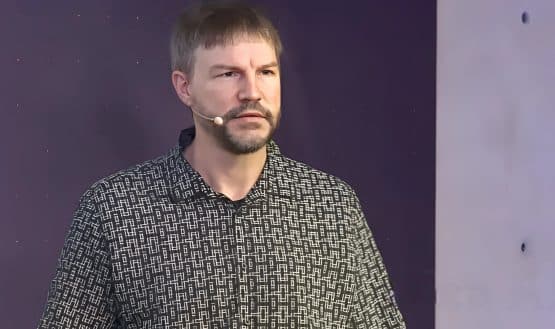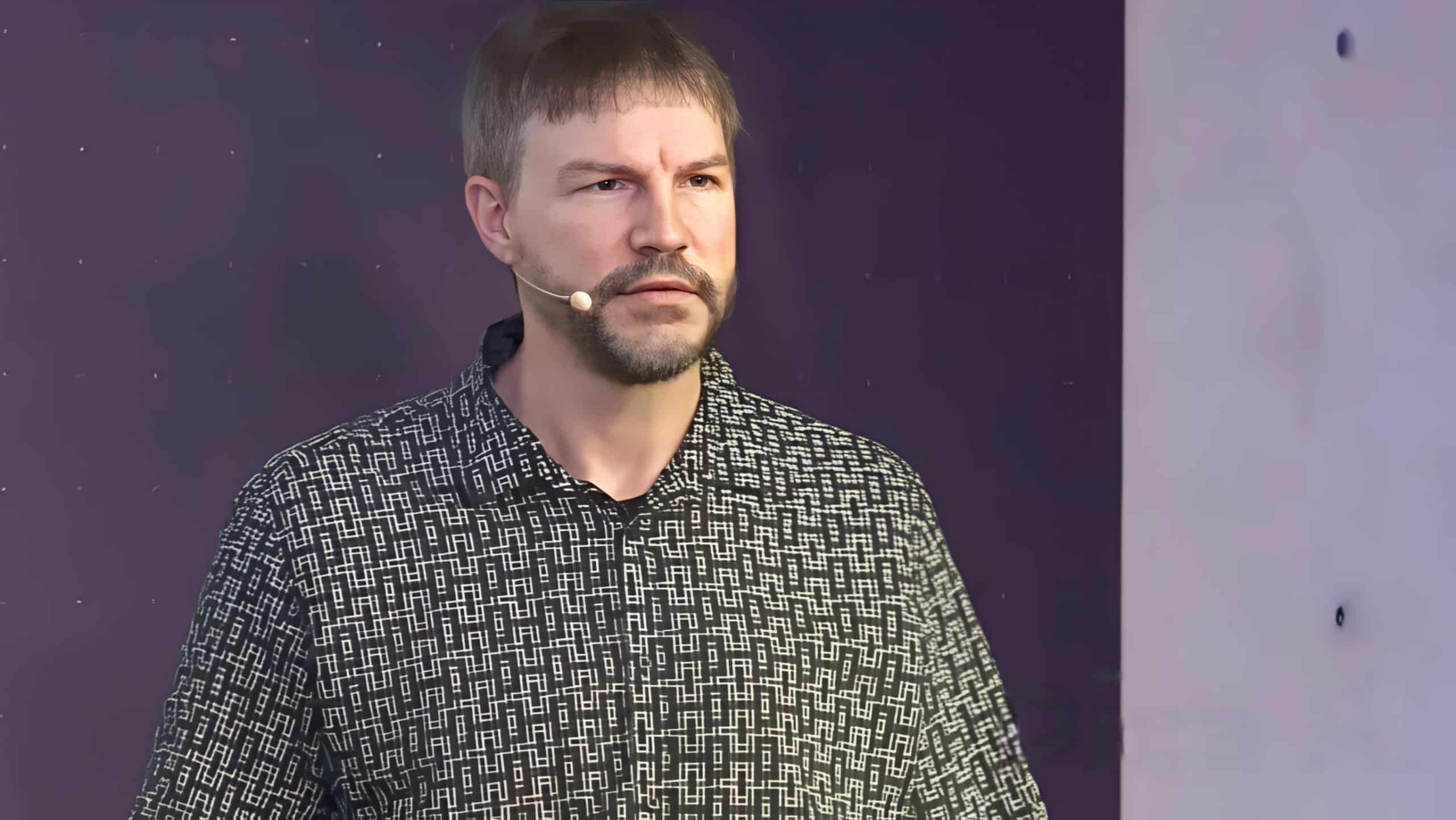On this Page:
Nick Szabo is a world-famous computer scientist, cryptographer, and legal scholar. He is best known for developing the concept of “smart contracts”, as well as for designing the decentralized digital money mechanism that the crypto community calls “Bit Gold”. As of 2025, Nick Szabo’s net worth is estimated at between $2 million and $5 million, but this figure is highly speculative, as Szabo maintains a private lifestyle and hasn’t publicly disclosed his crypto investments.
Today, Nick Szabo is best known for two major contributions to Bitcoin and cryptocurrency: the conceptualization of Bit Gold, considered a precursor to Bitcoin, and his ideas on smart contracts. Given Szabo’s involvement in digital currency and cryptography, there has been a lot of speculation that he might be Satoshi Nakamoto, the founder of Bitcoin, himself – a claim he has consistently denied over the years.
In this article, we dive into all that there is to know about Nick Szabo’s achievements, financial success, and the evidence supporting the theory that he is Satoshi Nakamoto.

Breaking Down Nick Szabo’s Net Worth in 2025
Nick Szabo has never publicly revealed much about his net worth or investments over the years, so no one knows exactly how much he is worth. However, judging by his extremely early involvement with Bitcoin and cryptocurrencies, he is likely worth at least a few million dollars.
Szabo has also not monetized his work through companies, blockchain projects, or ICOs (that we know of), making it even more difficult to estimate his net worth. It’s also entirely possible that Szabo is Satoshi Nakamoto (or part of a group of cryptographers going by the name Satoshi Nakamoto), which would put his net worth at over $86 billion in Bitcoin alone.
| Asset or Income Source | Contribution to Net Worth |
|---|---|
| Crypto holdings | Undisclosed (possibly Bitcoin) |
| Speaking arrangements | ~$20,000-$50,000 (based on industry standards) |
| Investments and assets | Undisclosed |
| JAN3 salary | Undisclosed |
| Total Net Worth | $2-$5 million |
Nick Szabo Net Worth: Early Life and Education
Nick Szabo was born on April 5, 1964. There is very little known about his childhood despite his fame and vital role in developing the crypto market. Szabo revealed in an interview that his father fought against the Soviet Union in the fifties, as part of the Hungarian uprising, confirming Szabo’s Hungarian descent.
Szabo graduated from the University of Washington in 1989 and holds a degree in computer science. After graduation, he obtained his Juris Doctor degree from George Washington University Law School.
In recognition of his significant contributions to cryptocurrency, Nick Szabo was awarded a prestigious academic title – an honorary professorship from Universidad Francisco Marroquín.
Szabo resides in Seattle, Washington, with his wife, Michelle Szabo. His assets, like real estate, remain undisclosed with the public.
The Biggest Crypto Mystery: Is Szabo Satoshi Nakamoto?
Thanks to his father, Szabo was raised with an understanding of the dangers of centralized authorities abusing their power. He has often referred to the many crimes and overreaches of the Soviet Union to underscore how dangerous such centralization can be. His family’s history exposed him to horror stories of property confiscation, authoritarian regimes, and governmental oppression. On many occasions, he has expressed that individuals raised in the United States might not fully grasp the potential for abuse by centralized authorities.
In his keynote at the Bitcoin 2021 conference, Nick Szabo talked about the evolution of money and Bitcoin’s role in addressing historical challenges associated with fiat currencies. He spoke of instances where reliance on fiat money led to economic failures, sharing that Bitcoin has the potential to offer a decentralized, robust alternative. He further shared that Bitcoin’s decentralized nature offers more financial security and reduces the reliance on centralized authorities, thereby offering a censorship-resistant monetary system.
Szabo’s foundational work in the cryptocurrency sphere make him a top contender in the search for the real identity of Bitcoin’s Creator, Satoshi Nakamoto. The hunt for Nakamoto has captivated millions of people with a massive variety of different theories.
While he consistently denied he was Satoshi, Szabo has acknowledged that his work in cryptography helped lay the foundation for Bitcoin.
Nick Szabo = Satoshi Nakamoto?
— WF (@WhaleFUD) December 27, 2022
– Worked on Bit Gold prior to Bitcoin being made since 2005.
– Speaks Japanese
– During an interview in 2017 he said:
“I’d definitely go for a second layer, I mean, I designed Bitcoi … gold with two layers.”
– Nick Szabo = NS = Nakamoto Satoshi
Nakamoto’s original address, which was used to send and receive the first bitcoin ever, holds over 100 BTC and keeps growing because of contributions. However, most experts believe that Nakamoto used multiple wallets to mine about 1 million Bitcoin in the early days.
If Nick Szabo really were Satoshi Nakamoto and if he does still own and control these wallets, he would likely be worth over $100 billion.
Several people have been linked to Nakamoto’s name so far, including Adam Back, Hal Finney, Craig Wright, Dorian Nakamoto, and Peter Todd. Wright tried to assume Satoshi’s identity for years, but a British court ruled that he was not Satoshi. The remaining people on this list all denied being Nakamoto.
Some experts argue that Satoshi Nakamoto was actually a group of activist cryptographers, likely overlapping with Cypherpunks, a group of brilliant computer scientists and mathematicians. Nick Szabo was known to be a Cypherpunk along with Hal Finney and Adam Back, both widely speculated to be Satoshi Nakamoto, lending credibility to the theory.
Nick Szabo Net Worth: Success with BitGold and Smart Contracts
Nick Szabo may or may not be Satoshi Nakamoto, but he certainly made pioneering contributions to the world of cryptocurrencies and blockchain technology. Straight after school, he took a keen interest in the financial markets and the digital marketplace. His first project after he graduated from the George Washington University Law School was eCash, a modest crypto project that paved his way in the industry.
Let’s see how the computer scientist contributed to decentralized digital currencies and cryptocurrency in general.
Szabo’s Work with eCash
eCash was a digital cash system founded by David Chaum, a cryptographer, in the 1980s. It was designed to enable anonymous and secure electronic transactions.
The concept behind this system was to create a form of money that mimicked the privacy and ease of using physical cash – but instead of being a traditional system, it would be a digital currency system. It relied on cryptographic protocols to ensure the security of transactions, as well as the user’s anonymity.
The eCash system was actually among the very first to incorporate digital signatures and blind signatures to prevent fraud and guarantee the transactions’ integrity.
Nick Szabo wasn’t directly involved in creating eCash, but he worked closely with Chaum to help grow the platform. Szabo’s most important projects, especially BitGold and smart contracts, were built on ideas originally explored in systems like eCash – with one major difference. Nick Szabo’s approach was focused on a decentralized currency, whereas eCash relied on a centralized authority for transaction verification.
— Cullen (@CullenHoback) October 13, 2024
Even though eCash didn’t have the same focus on decentralization as later cryptocurrencies, it was a significant milestone in the development of digital currencies. Nick Szabo built on the concepts of cryptography and secure digital transactions used in eCash and extended them to create BitGold.
Proposing the Idea of BitGold
In 1998, Nick Szabo proposed an early version of BitGold. He designed it to create a more secure online marketplace by using cryptographic proof-of-work instead of a centralized third party (like a bank or government).
Szabo had a single major goal with BitGold – to create a decentralized digital currency that replicates the properties of gold – specifically, its security and scarcity. The system was based on a process in which network users solve cryptographic problems to validate transactions, recording everything to a public ledger.
The concept of proof-of-work would later become one of the fundamental mechanisms in the design of Bitcoin (and other tech, such as email spam blockers). In addition to this, Szabo’s system also incorporated the idea of a public ledger or blockchain technology, which allows users to verify transactions in a decentralized manner.
BitGold never became a reality because the technology simply wasn’t viable yet. However, it helped plant the seed for the entire cryptocurrency industry. Satoshi Nakamoto was able to take the ideas of Szabo and other Cypherpunks, tweak them, and build a functioning cryptocurrency network.
Cryptocurrency most important areas for improvement over the next few years:
— Nick Szabo (@NickSzabo4) April 24, 2018
* More secure storage (key management)
* Trust-minimized (decentralized) exchanges
* Make 2nd layers more user-friendly, especially via automated routing, while not overly sacrificing trust minimization
Nick Szabo and His Link to Smart Contracts
Nick Szabo is also credited with pioneering concepts of self-executing digital contracts, also known as smart contracts, a major part of the foundation of Ethereum, the world’s second-largest cryptocurrency. He introduced this idea in 1994 and further developed it in the following years.
A smart contract is a self-executing contract with the terms of the agreement between buyer and seller written into the code. The contracts automatically execute when the conditions are met, without the need for any intermediaries.
In 1994, Szabo published a paper titled “Smart Contracts: Building Blocks for Digital Markets,” where he outlined his vision for creating this type of system. He envisioned these contracts as a way to eliminate reliance on banks or lawyers and create automated procedures to simplify the process.
Szabo might not have created Bitcoin or Ethereum, but the crypto market as it exists today would have likely never come to pass without Szabo’s work. Twenty years later, Vitalik Buterin adopted his idea of smart contracts and expanded on it to make Ethereum.
Public Speaking
These days, Nick Szabo is a sought-after speaker in the cryptocurrency circles. He has spoken at major industry events, including the Bitcoin 2020, 2021, and 2022 Conference. He has also participated in panels and lectures at institutions like Stanford, MIT, and the Blockchain Economic Forum.
We're EXTREMELY excited to announce our first Bitcoin 2020 speaker, Nick Szabo @NickSzabo4https://t.co/9FL7O0xiKs pic.twitter.com/xAubsZf07n
— The Bitcoin Conference (@TheBitcoinConf) October 8, 2019
Szabo hasn’t revealed how much he is paid for these talks, but given that he is one of the most influential minds in the sector, he’s likely paid handsomely. High-profile speakers often command fees ranging from $20,000 to $50,000 per engagement.
Szabo Joins JAN3
In January 2025, Nick Szabo joined JAN3, a digital infrastructure company that’s focused on accelerating global Bitcoin adoption. He is JAN3’s Chief Scientist. In his role, he leads research into BTC’s implications for international trade settlement, global adoption, and monetary policy.
The Lessons We Can Learn from Nick Szabo’s Brilliance
Nick Szabo’s story is one of privacy, innovation, and intellectual foresight. His contributions to digital currency and smart contracts make for invaluable lessons. He proved that visionary ideas backed by technical expertise can shape entire industries and, in this case, entirely redefine the way people interact with money and trust.
Szabo’s achievements highlight the power of computer programming language as a tool for change. One of his most important insights is the need for infrastructure that allows for secure, decentralized transactions between strangers. Traditional financial systems rely on governments, banks, and other intermediaries to establish trust.
Rejecting this reliance on intermediaries, Szabo envisioned a world where cryptographic protocols eliminate the need for third parties. His work laid the foundation for Bitcoin, Ethereum, DeFi, and just about everything else in the crypto world, proving that trust can be embedded in code instead of institutions.
Lastly, Szabo’s approach to privacy is also truly admirable. He could easily spend his time flaunting his wealth and success but instead he has continued to quietly focus building a better world for all of us.
FAQs
What is Nick Szabo's net worth in 2025?
Nick Szabo's net worth is estimated to be between $2 million and $5 million as of 2025. However, this figure is highly speculative since he hasn't publicly disclosed his crypto investments or assets.
How much Bitcoin does Nick Szabo have?
Szabo has never revealed how much Bitcoin he owns. Although many speculate that he holds quite a bit of BTC due to his early involvement in cryptocurrencies, Nick Szabo hasn't confirmed any Bitcoin holdings.
Did Nick Szabo found Bitcoin?
Nick Szabo denies being Satoshi Nakamoto and says he didn't develop Bitcoin. However, he is regarded as a key figure in the development of Bitcoin's concepts.
What is the link between Nick Szabo and Satoshi Nakamoto?
Many believe that Szabo could be Nakamoto, the mysterious creator of Bitcoin. Szabo has denied being Nakamoto, but the speculation remains strong.

